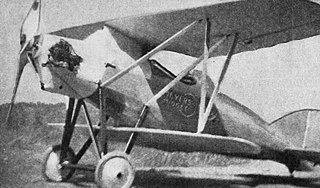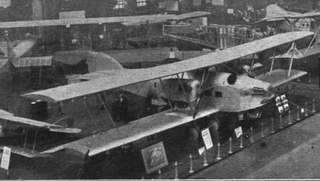
The ANEC III was a 1920s British six-seat passenger and mail carrier aircraft built by Air Navigation and Engineering Company Limited at Addlestone, Surrey.

The Handasyde monoplane was a single-seat light aircraft built for the 1923 Lympne motor glider competition. It competed there but won no prizes.
The Peyret Tandem or Peyret Alérion, was a French single seat glider of tandem wing configuration. It won first prize at the first British Glider Competition of 1922.

The Meyers Midget was a one-off small, low-powered, sporting single-seat sesquiplane, designed and built in the United States in 1926, incorporating several innovative structural features.
The Gabardini biplane was an Italian single seat biplane, designed and built near the beginning of World War I. It was an advanced trainer and could be fitted with engines of output between about 40 to 80 kW.

The Stahlwerk-Mark R.V, sometimes known as the Stahlwerk-Mark R.V/23 to indicate its year of production, was a small German airliner able to carry three passengers. Two were built.

The Blériot XXI was an early French aircraft built by Blériot Aéronautique.

The Potez XVIII was a French airliner from the early 1920s, a three-engine biplane carrying up to twelve passengers.
The Caudron C.91 was a French single engine biplane with an enclosed passenger cabin seating four. It first flew in 1923.

The 1923 Feiro I was the first Hungarian designed and built civil transport aircraft, modified in 1925 by an engine change into the Feiru Daru (Crane). Neither was a commercial success.

The Nieuport-Delage NiD 590 was a three engine, high wing monoplane designed for policing and other roles in France's colonies, which did not go into production or enter service.

The Nieuport-Delage NiD 580 R.2 was a contender for a French government contract for a long range, two seat reconnaissance aircraft, issued in 1928. There were eight prototypes in the 1931-2 contest and the NiD 580 was not selected for production.
The Neiuport-Delage NiD 690 was a French all-metal, single-engined colonial policing aircraft, built for a competitive government contract. Its unusual rear fuselage gave a wide field of downward machine gun fire. Only two examples were built.
The Blériot 117 or B-117 was a large, twin-engined French aircraft from the mid-1920s. Heavily armed with three gun positions, it was designed to defend bomber formations against fighter attack. It did not reach production but was developed into the successful Blériot 127.

The Hanriot H.25 was a French, single-engined, six passenger airliner built in 1926. Only one was flown.

The Działowski D.K.D.1 was the first powered aircraft designed by Stanislaw Działowski. It was a low-power high-wing monoplane with a cabin for one passenger. After attending an aviation exhibition in Warsaw in 1927 it was badly damaged when the engine failed as it left and it did not fly again.
The Gabriel Śląsk (Silesia) was a Polish light aircraft designed and built by an amateur in the mid-1930s. After two flights the Polish authorities banned further development.
The Simplex Red Arrow was a US single-engined monoplane produced in the late 1920s and early 1930s and intended as club machine or mail transport. Most used radial engines in the 90–110 hp (67–82 kW) range. They carried one or two passengers whose seats could be open or enclosed. One variant, the Red Arrow Dual Plane, was easily converted from monoplane to biplane and was available with two versions of the much more powerful Wright Whirlwind engines. In all about 20 were built.

The Wallace Touroplane was a late 1920s U.S. three seat, high wing cabin monoplane. About 20 were built.
The Nicholson Junior KN-2 was a low power, high wing, two seat, cabin monoplane intended for sport or flight training in the United States in the late 1920s. Only one was built.












